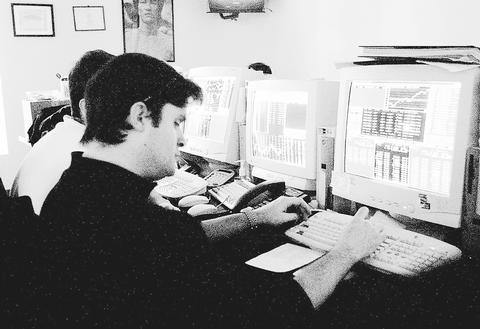Even at the height of the bull market, Lowell Koppel did not fit the mold of the hyperactive day trader who jumped in and out of technology stocks dozens of times a day. Instead, he relied on evenhanded options strategies to generate consistent returns that had little to do with the Internet stock bubble.
Maybe that is why, after two years of stock market declines, Koppel, 66, a former software executive, is still trading 100 times a month. Last year, he said, his trading returned 11.5 percent. "I'm a conservative investor," he said from his home in Winchester, Massachusetts. "I only use about 25 percent of my assets to do this stuff with. The rest is in bonds."

PHOTO: NY TIMES
Day trading became a prominent part of the market landscape in the late 1990s as individual investors using online trading technology left their day jobs and leveraged their nest eggs to trade stocks, often jumping in and out of positions within minutes. The market downturn that began in early 2000 thinned these ranks by the thousands and forced out of business many firms that had provided traders with training, trading privileges and technology.
Many individual traders who remain have adopted relatively conservative approaches. They say they are holding positions longer, using less aggressive strategies, diversifying their holdings and relying more on short-selling, the practice of borrowing shares to sell in the hopes of buying them back later at a lower price.
"In the old days it was, 'Buy whatever you can afford and go home happy,"' said Joseph Cammarata, president of Sonic Trading, a day-trading firm in New York. "Now, you have to try to preserve capital."
Michael Parness, 38, who runs TrendFund.com, which dispenses trading advice online, said, "I think the main difference is that you have to be willing to take less." The title of Parness' new book,
"Everyone who's trading now is actually doing this for a living," said Don Bright, the head of Bright Trading, a day-trading firm with 42 offices and 600 clients in the US. "The people who treated it like selling real estate on the weekends are gone."
Koppel, who has been trading for three years, said he had never been comfortable with pure stock trading. Trained as a chemical engineer, he gravitated to the complex math of options and spends days analyzing them for potential mispricings.
"It's really only in the last six months that I've gotten my calculations to the point where I feel confident," Koppel said, adding that he gets most of his income from writing covered calls, a conservative strategy that involves buying stock and selling call options. The strategy sacrifices potential appreciation in the shares for guaranteed income from the sale of the options.
The confidence was tested when the market was near its peaks, Koppel said. "Sometimes I felt bad because the stock indices were performing so well and the opportunity loss was large. Now, though, I just try to consistently make money and not worry about the indices."
Teresa Appleton-Lutz, 37, began trading five years ago after leaving a job at Hewlett-Packard to care for her two children. She has moved from trading initial offerings and technology stocks that were so fashionable in 1999 to trading futures contracts.
"It was so easy to find something to trade then," Appleton-Lutz said. For seven months, she said, she traded only three stocks, Ciena, Exxon Mobil and Mercury Interactive, a strategy that was successful until the market changed.
Now she takes comfort in trading E-minifutures, contracts based on major indexes like the Standard & Poor's 500 or the NASDAQ 100 but sliced into smaller pieces for individual investors, and in reading books on charting, technical analysis and more sophisticated techniques. "When you trade futures on the market, you don't have to worry about a biotech company saying the FDA is investigating it," she said. "You don't have to sweat that kind of stuff. You want to live to trade another day."
While their numbers have dwindled, active traders are prized by securities firms, which cater to their needs. Electronic trading systems -- often called direct-access trading -- have become widely available to those who want to trade often, but not necessarily at the pace of the day traders of the Internet boom.
Some of the biggest companies in the online brokerage business, like Charles Schwab, Ameritrade and ETrade, have taken steps to increase offerings for active traders in order to diversify their own revenue mix.
In early 2000, Schwab acquired CyberCorp, a direct-access trading firm, and renamed it CyberTrader. Since the takeover, the firm's active-trader roll has swelled to 10,000 from 2,500, Schwab executives say. That has helped the company weather a slump in the broader online trading business. Schwab added just 47,000 accounts in the fourth quarter of 2001, down from its peak of 359,000 in the first quarter of 2000; new accounts at Ameritrade dropped to 35,000 from 306,000 over the same period, according to a report from Putnam Lovell, an investment bank in San Francisco.
ETrade licensed direct-access software from AB Watley, a day-trading firm, and Ameritrade uses direct-access software developed by TradeCast, another firm with day-trading roots.
"Active traders still are a very important part of the business," said Richard Repetto, an e-finance analyst at Putnam Lovell. "They're a small part of the customer base, but they are very profitable."
Repetto said CyberTrader clients account for 13,500 of the 155,000 trades done "on an average day" through Charles Schwab. Considering that the firm has 7.5 million clients, the trades by the 10,000 at CyberTrader represent a significant chunk of business.
"Active trading is a viable piece of a big firm with a vertical strategy" that includes services beyond direct-access capability, said Gary Mednick, an executive vice president at AB Watley.

To many, Tatu City on the outskirts of Nairobi looks like a success. The first city entirely built by a private company to be operational in east Africa, with about 25,000 people living and working there, it accounts for about two-thirds of all foreign investment in Kenya. Its low-tax status has attracted more than 100 businesses including Heineken, coffee brand Dormans, and the biggest call-center and cold-chain transport firms in the region. However, to some local politicians, Tatu City has looked more like a target for extortion. A parade of governors have demanded land worth millions of dollars in exchange

An Indonesian animated movie is smashing regional box office records and could be set for wider success as it prepares to open beyond the Southeast Asian archipelago’s silver screens. Jumbo — a film based on the adventures of main character, Don, a large orphaned Indonesian boy facing bullying at school — last month became the highest-grossing Southeast Asian animated film, raking in more than US$8 million. Released at the end of March to coincide with the Eid holidays after the Islamic fasting month of Ramadan, the movie has hit 8 million ticket sales, the third-highest in Indonesian cinema history, Film

Taiwan Semiconductor Manufacturing Co’s (TSMC, 台積電) revenue jumped 48 percent last month, underscoring how electronics firms scrambled to acquire essential components before global tariffs took effect. The main chipmaker for Apple Inc and Nvidia Corp reported monthly sales of NT$349.6 billion (US$11.6 billion). That compares with the average analysts’ estimate for a 38 percent rise in second-quarter revenue. US President Donald Trump’s trade war is prompting economists to retool GDP forecasts worldwide, casting doubt over the outlook for everything from iPhone demand to computing and datacenter construction. However, TSMC — a barometer for global tech spending given its central role in the

Alchip Technologies Ltd (世芯), an application-specific integrated circuit (ASIC) designer specializing in server chips, expects revenue to decline this year due to sagging demand for 5-nanometer artificial intelligence (AI) chips from a North America-based major customer, a company executive said yesterday. That would be the first contraction in revenue for Alchip as it has been enjoying strong revenue growth over the past few years, benefiting from cloud-service providers’ moves to reduce dependence on Nvidia Corp’s expensive AI chips by building their own AI accelerator by outsourcing chip design. The 5-nanometer chip was supposed to be a new growth engine as the lifecycle